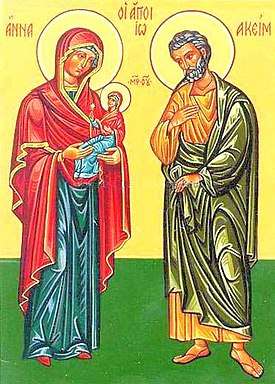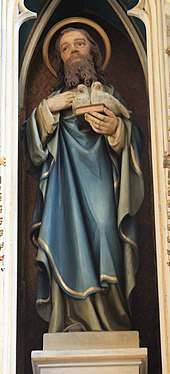Joachim
Joachim (/ˈdʒoʊəkɪm/; "he whom Yahweh has set up", Hebrew: יְהוֹיָקִים Yəhôyāqîm, Greek Ἰωακείμ Iōākeím) was, according to some apocryphal writings, the husband of Saint Anne and the father of Mary, the mother of Jesus. The story of Joachim and Anne first appears in the apocryphal Gospel of James. Joachim and Anne are not mentioned in the Bible.[1] His feast day is 26 July.
Saint Joachim | |
|---|---|
 Saints Joachim and Anne, Parents of the Virgin Mary | |
| Father of the Blessed Virgin Mary; Confessor | |
| Born | Around 50 BC Nazareth |
| Died | 15 AD, Jerusalem Nazareth |
| Venerated in | Roman Catholic Church Eastern Catholic Churches Eastern Orthodox Church Oriental Orthodox Church Anglican Communion Lutheranism Islam |
| Canonized | Pre-Congregation |
| Feast | 26 July (Anglican Communion), (Catholic Church); 9 September (Eastern Orthodox Church), (Greek Catholics); Calendar, 1738-1913); 16 August (General Roman Calendar, 1913-1969) |
| Attributes | Lamb, doves, with Saint Anne or Mary |
| Patronage | Fathers, grandparents. Adjuntas, Puerto Rico; Dolores, Eastern Samar; Fasnia (Tenerife) |
In Christian tradition
According to tradition, Saint Anne was born in Bethlehem, and married Joachim of Nazareth. In the Protoevangelium of James, Joachim is described as a rich and pious man, who regularly gave to the poor. Tradition has it that the parents of the Blessed Virgin, who, apparently, first lived in Galilee, came later on to settle in Jerusalem.[2]
At the temple, Joachim's sacrifice was rejected, as the couple's childlessness was interpreted as a sign of divine displeasure. Joachim consequently withdrew to the desert, where he fasted and did penance for 40 days. Angels then appeared to both Joachim and Anne to promise them a child.[3]
Joachim later returned to Jerusalem and embraced Anne at the city gate, located in the Walls of Jerusalem. An ancient belief held that a child born of an elderly mother who had given up hope of having offspring was destined for great things. Parallels occur in the Old Testament in the case of Hannah, mother of Samuel,[4] and in the New Testament in the case of the parents of St John the Baptist.
The cycle of legends concerning Joachim and Anne was included in the Golden Legend (around 1260) by Jacobus da Varagine. This cycle remained popular in Christian art until the Council of Trent (1545–1563) restricted the depiction of apocryphal events.
No liturgical celebration of Saint Joachim was included in the Tridentine Calendar. It was added to the General Roman Calendar in 1584, for celebration on 20 March, the day after the feast day of Saint Joseph. In 1738, it was transferred to the Sunday after the Octave of the Assumption of Mary. As part of his effort to allow the liturgy of Sundays to be celebrated, Pope Pius X (term 1903-1914) transferred it to 16 August, the day after the Assumption, so Joachim may be remembered in the celebration of Mary's triumph.[5] It was then celebrated as a Double of the Second Class, a rank that was changed in 1960 to that of Second Class Feast. In the 1969 revision of the General Roman Calendar, it was joined to that of Anne, for celebration on 26 July.[6]

The Eastern Orthodox Churches and Greek Catholics commemorate Joachim on 9 September, the Synaxis of Joachim and Anne, the day after the Nativity of the Theotokos.
In Islam
In the Quran, the father of Mary, mother of Jesus is known as Imran (ʿImrān). In the Quran, a whole chapter, Al Imran, is named after his family. The name is mentioned in several locations and it is said that his family was one of those preferred over all of God's creatures: "Lo! God preferred Adam and Noah and the Family of Abraham and the Family of 'Imran above (all His) creatures."[Quran 3:33 (Translated by Pickthall)]
It has been narrated in Shi'i hadith from Abu Basir that Ja'far al-Sadiq, the Twelver Imam confirmed that Imran was a prophet and apostle to his people, further stating "Hannah, the wife of Imran, and Ishba, the wife of Zechariah, were sisters. He goes on to say that Mary was born from Hannah and John the Baptist was born from Ishba. Mary gave birth to Jesus and he was the son of the daughter of John's aunt. John was the son of the aunt of Mary, and the aunt of one's mother is like one's aunt."[7]
Although Islamic studies of the beginning of the 20th century tended to note genealogical discrepancies, in more recent Islamic Studies of the 21st century the general consensus is, according to Angelika Neuwirth, Nicolai Sinai & Michael Marx, that the Quran does not make a genealogical error but instead makes use of Typology.[8] This is, following Wensincks conclusion, supported by the figurative speech of the Quran and the Islamic tradition: "Maryam is called a sister of Hārūn and the use of these three names ‘Imrān, Hārūn and Maryam, has led to the supposition that the Kur'ān does not clearly distinguished between the two Maryams, of the Old and the New Testaments. It is not necessary to assume that these kinship links are to interpreted in modern terms. The words "sister" and "daughter", like their male counterparts, in Arabic usage can indicate extended kinship, descendance or spiritual affinity. Muslim tradition is clear that there are eighteen centuries between the Biblical ‘Amram and the father of Maryam".[9][10] Similarly, Stowasser concludes that "to confuse Mary the mother of Jesus with Mary the sister of Moses and Aaron in Torah is completely wrong and in contradiction to the sound Hadith and the Qur'anic text as we have established".[11][12]
Patronage
Joachim is named as the patron saint of fathers, grandfathers, grandparents, married couples, cabinet makers, and linen traders.[13]
Iconography

In medieval art he often wears a conical Jewish hat. He is often treated as a saint, with a halo, but in the Western church there was some awareness that he had quite likely died too soon to strictly be counted as a Christian.
Joachim and Anne Meeting at the Golden Gate was a popular subject in artistic renditions of the life of the Virgin.
Symbols associated with Saint Joachim include a book or scroll representing linen makers, a shepherd's staff for the Christian Word, and a basket of doves representing peace. He is almost always clothed in green, the color of hope.[13]
The name of the San Joaquin River dates to 1805–1808, when Spanish explorer Gabriel Moraga was surveying east from Mission San José in order to find possible sites for a mission. The name was in common use by 1810.[14]
See also
- Chronological list of saints in the 1st century
- Joachim, patron saint archive
References
- Brownrigg, Ronald. Who's Who in the New Testament 2001 ISBN 0-415-26036-1 page T-62
- "Souvay, Charles. "St. Joachim." The Catholic Encyclopedia. Vol. 8. New York: Robert Appleton Company, 1910. 3 May 2013". Newadvent.org. 1910-10-01. Retrieved 2013-11-03.
- "Saint Joachim", World Meeting of Families, 2015 Archived 2016-04-02 at the Wayback Machine
- "''Lives of Saints'', John J. Crawley & Co., Inc". Ewtn.com. Retrieved 2013-11-03.
- Dom Gaspar LeFebvre, "The Saint Andrew Daily Missal, with Vespers for Sundays and Feasts," Saint Paul, MN: The E. M. Lohmann Co., 1952, p. 1513
- "Calendarium Romanum" (Libreria Editrice Vaticana 1969), pp. 98 and 135
- Muntazir Qa'im, Mahdi (2007). Jesus Through the Qur’an and Shi’ite Narrations (Bilingual ed.). Queens, New York: Tahrike Tarsile Qur'an. pp. 14–15. ISBN 978-1879402140.
- Michael Marx: Glimpses of a Mariology in the Qur'an; in: A. Neuwirth, Nicolai Sinai, Michael Marx (Hrsg.): The Qur'ān in Context. Historical and Literary Investigations into the Qur'ānic Milieu. Leiden 2011. pp. 533–563.
- Arent Jan Wensinck: Maryam. In: A. J. Wensinck, J. H. Kramers (Hrsg.): Handwörterbuch des Islam. pp. 421–423.
- A. J. Wensinck (Penelope Johnstone), "Maryam" in C. E. Bosworth, E. van Donzel, W. P. Heinrichs & Ch. Pellat (Eds.), The Encyclopaedia Of Islam (New Edition), 1991, Volume VI, p. 630. Maryam is called a sister of Hārūn (sūra XIX, 29), and the use of these three names ‘Imrān, Hārūn and Maryam, has led to the supposition that the Kur'ān does not clearly distinguished between the two Maryams, of the Old and the New Testaments. The Kur'ān names two families as being especially chosen: those of Ibrāhim and of ‘Imrān (sūra III, 32). It is the family of ‘Imrān, important because of Moses and Aaron, to which Maryam belongs. It is not necessary to assume that these kinship links are to interpreted in modern terms. The words "sister" and "daughter", like their male counterparts, in Arabic usage can indicate extended kinship, descendance or spiritual affinity. This second ‘Imrān, together with Harun, can be taken as purely Kur'ānic... Muslim tradition is clear that there are eighteen centuries between the Biblical ‘Amram and the father of Marya.
- B. F. Stowasser, Women In The Qur'an, Traditions, And Interpretation, 1994, Oxford University Press: New York, p. 393-394.
- Aliah Schleifer, Mary The Blessed Virgin Of Islam, 1998, op. cit., p. 36.
- ""St. Joachim, Father of the Most Blessed Virgin", St. Joachim Parish, Bellmawr, New Jersey". Stjoachimparish.net. Retrieved 2013-11-03.
- Gudde, Erwin G.; Bright, William (2004). California Place Names: The Origin and Etymology of Current Geographical Names. University of California Press. p. 337 ISBN 0-520-24217-3
External links
| Wikimedia Commons has media related to Saint Joachim. |
